Abarth 500 2017 Owner handbook (in English)
Manufacturer: ABARTH, Model Year: 2017, Model line: 500, Model: Abarth 500 2017Pages: 192, PDF Size: 6.46 MB
Page 51 of 192
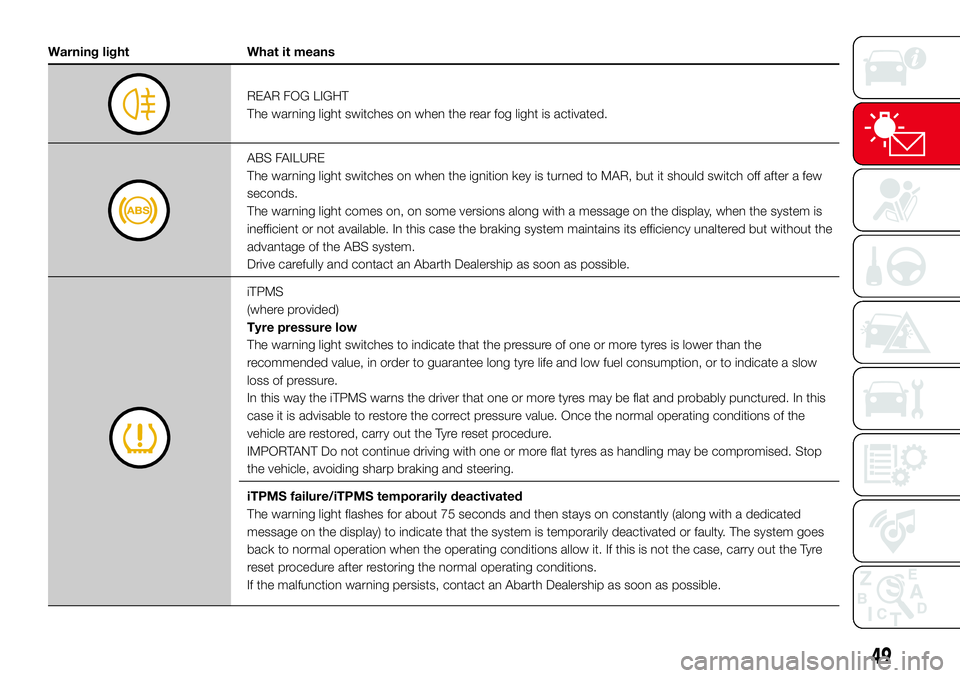
Warning light What it means
REAR FOG LIGHT
The warning light switches on when the rear fog light is activated.
ABS FAILURE
The warning light switches on when the ignition key is turned to MAR, but it should switch off after a few
seconds.
The warning light comes on, on some versions along with a message on the display, when the system is
inefficient or not available. In this case the braking system maintains its efficiency unaltered but without the
advantage of the ABS system.
Drive carefully and contact an Abarth Dealership as soon as possible.
iTPMS
(where provided)
Tyre pressure low
The warning light switches to indicate that the pressure of one or more tyres is lower than the
recommended value, in order to guarantee long tyre life and low fuel consumption, or to indicate a slow
loss of pressure.
In this way the iTPMS warns the driver that one or more tyres may be flat and probably punctured. In this
case it is advisable to restore the correct pressure value. Once the normal operating conditions of the
vehicle are restored, carry out the Tyre reset procedure.
IMPORTANT Do not continue driving with one or more flat tyres as handling may be compromised. Stop
the vehicle, avoiding sharp braking and steering.
iTPMS failure/iTPMS temporarily deactivated
The warning light flashes for about 75 seconds and then stays on constantly (along with a dedicated
message on the display) to indicate that the system is temporarily deactivated or faulty. The system goes
back to normal operation when the operating conditions allow it. If this is not the case, carry out the Tyre
reset procedure after restoring the normal operating conditions.
If the malfunction warning persists, contact an Abarth Dealership as soon as possible.
49
Page 52 of 192
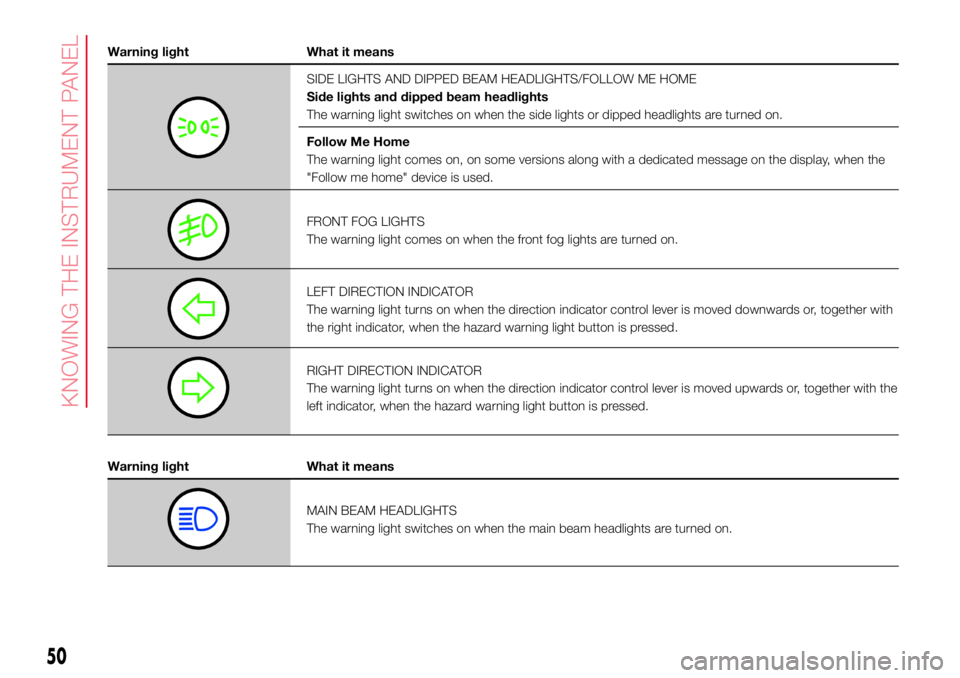
Warning light What it means
SIDE LIGHTS AND DIPPED BEAM HEADLIGHTS/FOLLOW ME HOME
Side lights and dipped beam headlights
The warning light switches on when the side lights or dipped headlights are turned on.
Follow Me Home
The warning light comes on, on some versions along with a dedicated message on the display, when the
"Follow me home" device is used.
FRONT FOG LIGHTS
The warning light comes on when the front fog lights are turned on.
LEFT DIRECTION INDICATOR
The warning light turns on when the direction indicator control lever is moved downwards or, together with
the right indicator, when the hazard warning light button is pressed.
RIGHT DIRECTION INDICATOR
The warning light turns on when the direction indicator control lever is moved upwards or, together with the
left indicator, when the hazard warning light button is pressed.
Warning light What it means
MAIN BEAM HEADLIGHTS
The warning light switches on when the main beam headlights are turned on.
50
KNOWING THE INSTRUMENT PANEL
Page 53 of 192

INSTRUMENT PANEL WARNING SYMBOLS
Symbol What it means
DOORS/BONNET/LUGGAGE COMPARTMENT OPEN
The symbols on the display switches on, together with a dedicated message, on some versions, when one
or more doors, the tailgate or the bonnet (where provided) are not properly closed. An acoustic signal is
also emitted with the doors open and the car in motion.
LOW BATTERY CHARGE
If the warning light or the symbol on the display (together with a dedicated message on the display on
some versions) remains on, contact an Abarth Dealership immediately.
INSUFFICIENT ENGINE OIL PRESSURE/ENGINE OIL DETERIORATED
When the key is turned to MAR the icon appears (where present), but should disappear as soon as the
engine is started.
NOTE Where present, the warning light may be amber
Low engine oil pressure
The symbol appears continuously together with the message on the display (where present) when the
system detects that the engine oil pressure is insufficient.
36)
51
Page 54 of 192
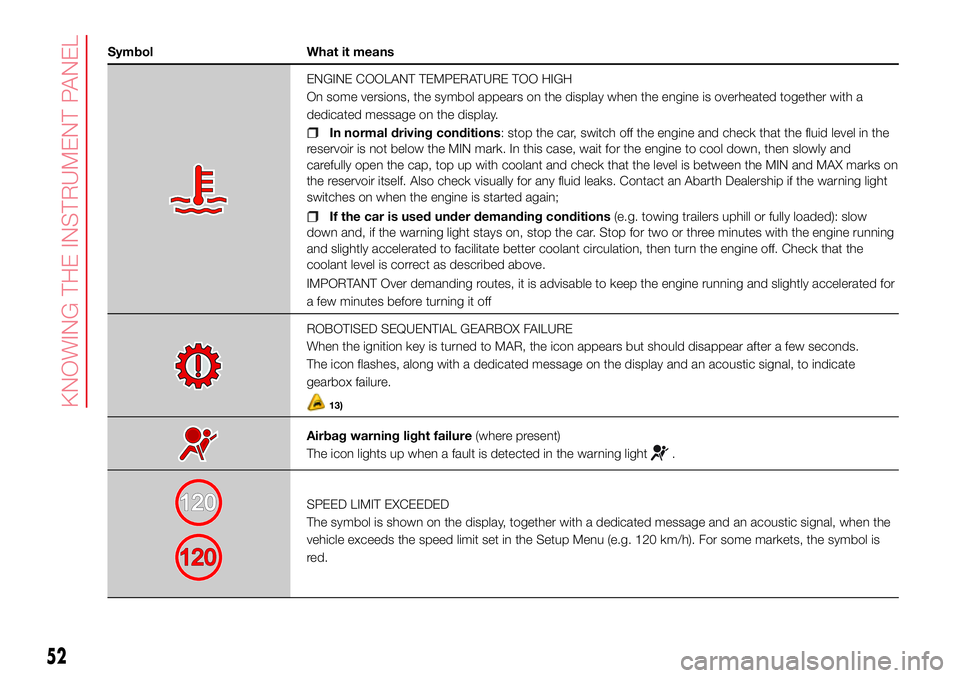
Symbol What it means
ENGINE COOLANT TEMPERATURE TOO HIGH
On some versions, the symbol appears on the display when the engine is overheated together with a
dedicated message on the display.
In normal driving conditions: stop the car, switch off the engine and check that the fluid level in the
reservoir is not below the MIN mark. In this case, wait for the engine to cool down, then slowly and
carefully open the cap, top up with coolant and check that the level is between the MIN and MAX marks on
the reservoir itself. Also check visually for any fluid leaks. Contact an Abarth Dealership if the warning light
switches on when the engine is started again;
If the car is used under demanding conditions(e.g. towing trailers uphill or fully loaded): slow
down and, if the warning light stays on, stop the car. Stop for two or three minutes with the engine running
and slightly accelerated to facilitate better coolant circulation, then turn the engine off. Check that the
coolant level is correct as described above.
IMPORTANT Over demanding routes, it is advisable to keep the engine running and slightly accelerated for
a few minutes before turning it off
ROBOTISED SEQUENTIAL GEARBOX FAILURE
When the ignition key is turned to MAR, the icon appears but should disappear after a few seconds.
The icon flashes, along with a dedicated message on the display and an acoustic signal, to indicate
gearbox failure.
13)
Airbag warning light failure(where present)
The icon lights up when a fault is detected in the warning light
.
SPEED LIMIT EXCEEDED
The symbol is shown on the display, together with a dedicated message and an acoustic signal, when the
vehicle exceeds the speed limit set in the Setup Menu (e.g. 120 km/h). For some markets, the symbol is
red.
52
KNOWING THE INSTRUMENT PANEL
Page 55 of 192
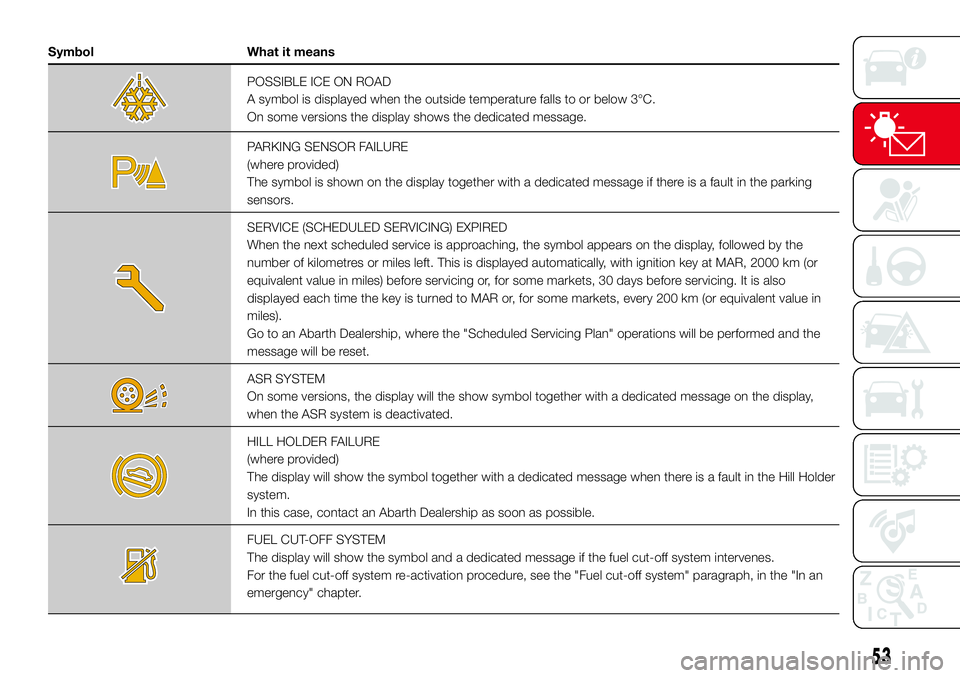
Symbol What it means
POSSIBLE ICE ON ROAD
A symbol is displayed when the outside temperature falls to or below 3°C.
On some versions the display shows the dedicated message.
PARKING SENSOR FAILURE
(where provided)
The symbol is shown on the display together with a dedicated message if there is a fault in the parking
sensors.
SERVICE (SCHEDULED SERVICING) EXPIRED
When the next scheduled service is approaching, the symbol appears on the display, followed by the
number of kilometres or miles left. This is displayed automatically, with ignition key at MAR, 2000 km (or
equivalent value in miles) before servicing or, for some markets, 30 days before servicing. It is also
displayed each time the key is turned to MAR or, for some markets, every 200 km (or equivalent value in
miles).
Go to an Abarth Dealership, where the "Scheduled Servicing Plan" operations will be performed and the
message will be reset.
ASR SYSTEM
On some versions, the display will the show symbol together with a dedicated message on the display,
when the ASR system is deactivated.
HILL HOLDER FAILURE
(where provided)
The display will show the symbol together with a dedicated message when there is a fault in the Hill Holder
system.
In this case, contact an Abarth Dealership as soon as possible.
FUEL CUT-OFF SYSTEM
The display will show the symbol and a dedicated message if the fuel cut-off system intervenes.
For the fuel cut-off system re-activation procedure, see the "Fuel cut-off system" paragraph, in the "In an
emergency" chapter.
53
Page 56 of 192
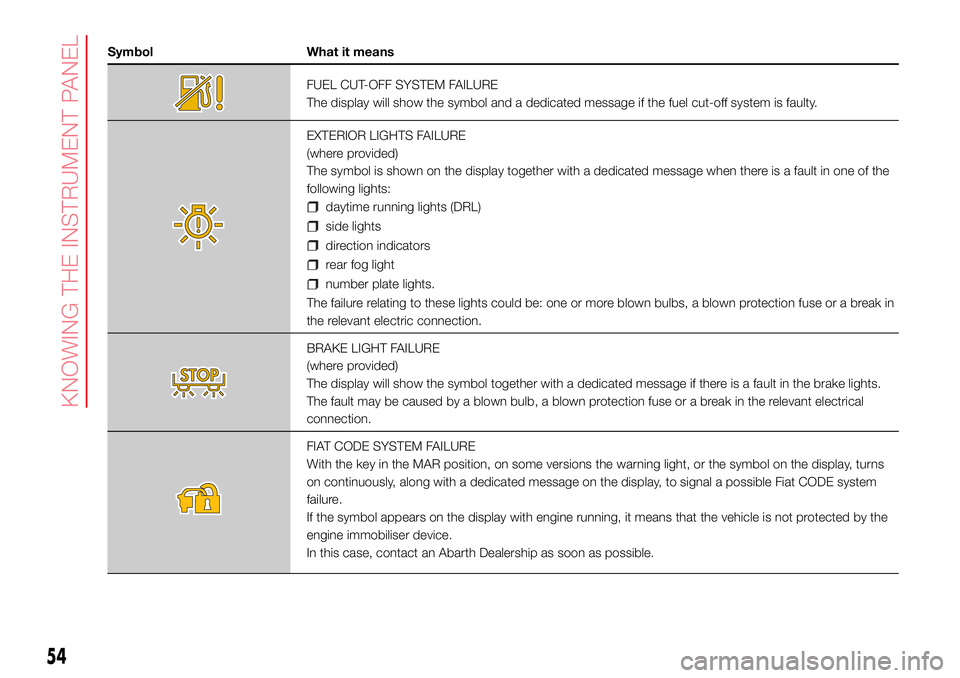
Symbol What it means
FUEL CUT-OFF SYSTEM FAILURE
The display will show the symbol and a dedicated message if the fuel cut-off system is faulty.
EXTERIOR LIGHTS FAILURE
(where provided)
The symbol is shown on the display together with a dedicated message when there is a fault in one of the
following lights:
daytime running lights (DRL)
side lights
direction indicators
rear fog light
number plate lights.
The failure relating to these lights could be: one or more blown bulbs, a blown protection fuse or a break in
the relevant electric connection.
BRAKE LIGHT FAILURE
(where provided)
The display will show the symbol together with a dedicated message if there is a fault in the brake lights.
The fault may be caused by a blown bulb, a blown protection fuse or a break in the relevant electrical
connection.
FIAT CODE SYSTEM FAILURE
With the key in the MAR position, on some versions the warning light, or the symbol on the display, turns
on continuously, along with a dedicated message on the display, to signal a possible Fiat CODE system
failure.
If the symbol appears on the display with engine running, it means that the vehicle is not protected by the
engine immobiliser device.
In this case, contact an Abarth Dealership as soon as possible.
54
KNOWING THE INSTRUMENT PANEL
Page 57 of 192
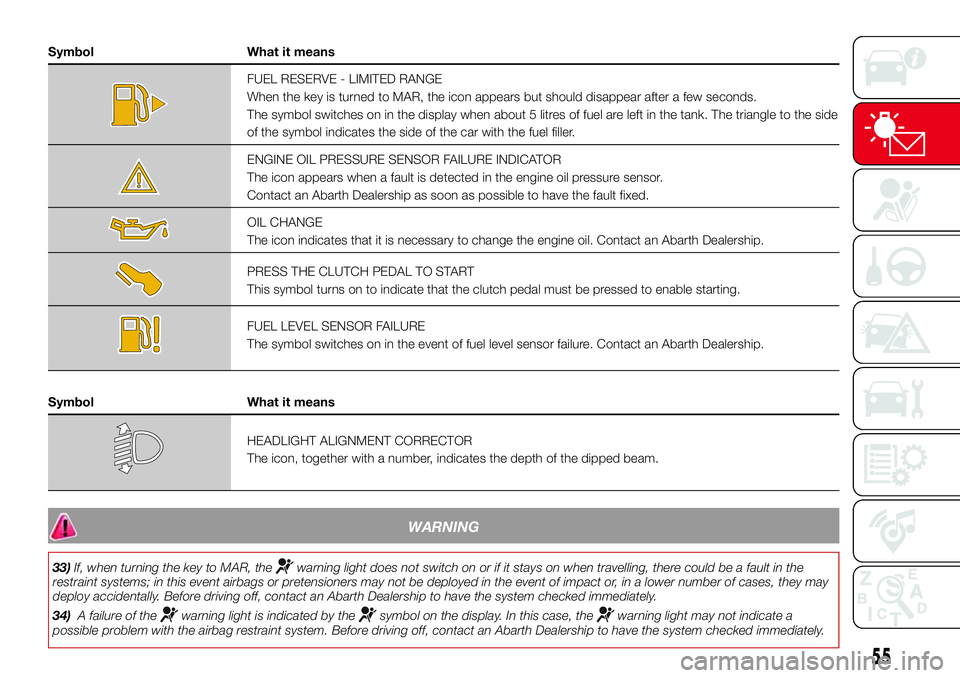
Symbol What it means
FUEL RESERVE - LIMITED RANGE
When the key is turned to MAR, the icon appears but should disappear after a few seconds.
The symbol switches on in the display when about 5 litres of fuel are left in the tank. The triangle to the side
of the symbol indicates the side of the car with the fuel filler.
ENGINE OIL PRESSURE SENSOR FAILURE INDICATOR
The icon appears when a fault is detected in the engine oil pressure sensor.
Contact an Abarth Dealership as soon as possible to have the fault fixed.
OIL CHANGE
The icon indicates that it is necessary to change the engine oil. Contact an Abarth Dealership.
PRESS THE CLUTCH PEDAL TO START
This symbol turns on to indicate that the clutch pedal must be pressed to enable starting.
FUEL LEVEL SENSOR FAILURE
The symbol switches on in the event of fuel level sensor failure. Contact an Abarth Dealership.
Symbol What it means
HEADLIGHT ALIGNMENT CORRECTOR
The icon, together with a number, indicates the depth of the dipped beam.
WARNING
33)If, when turning the key to MAR, thewarning light does not switch on or if it stays on when travelling, there could be a fault in the
restraint systems; in this event airbags or pretensioners may not be deployed in the event of impact or, in a lower number of cases, they may
deploy accidentally. Before driving off, contact an Abarth Dealership to have the system checked immediately.
34)A failure of the
warning light is indicated by thesymbol on the display. In this case, thewarning light may not indicate a
possible problem with the airbag restraint system. Before driving off, contact an Abarth Dealership to have the system checked immediately.
55
Page 58 of 192

35)If thewarning light turns on when travelling (on certain versions together with the message on the display) stop the vehicle
immediately and contact an Abarth Dealership.
36)If the
warning light switches on when driving (on certain versions together with a dedicated message on the display) stop the engine
immediately and contact an Abarth Dealership.
37)If the warning light flashes or the symbol is constantly on, depending on the versions, there is a fault in the system. If this is the case, go
to an Abarth Dealership to have the system checked.
38)If, when the ignition key is turned to MAR, the
warning light does not switch on, switches on constantly or flashes when driving (on
certain versions together with the message on the display), contact an Abarth Dealership as soon as possible. The operation of the
warning light may be checked by the traffic police using specific devices. Comply with the laws and regulations of the country where you
are driving.
WARNING
13)If there is a fault in the gearbox, contact an Abarth Dealership as soon as possible to check the system.
56
KNOWING THE INSTRUMENT PANEL
Page 59 of 192

SAFETY
The chapter that you are about to read
is very important: it describes the
safety systems with which the vehicle is
equipped and provides instructions on
how to use them correctly.ACTIVE SAFETY SYSTEMS ............ 58
ITPMS SYSTEM (INDIRECT TYRE
PRESSURE MONITORING
SYSTEM) ........................................ 61
OCCUPANT PROTECTION
SYSTEMS ....................................... 63
SEAT BELTS ................................... 64
SBR SYSTEM (SEAT BELT
REMINDER) .................................... 65
PRE-TENSIONERS ......................... 65
CHILD PROTECTION SYSTEMS ..... 67
SUPPLEMENTARY RESTRAINT
SYSTEM (SRS) – AIRBAG ............... 74
57
Page 60 of 192
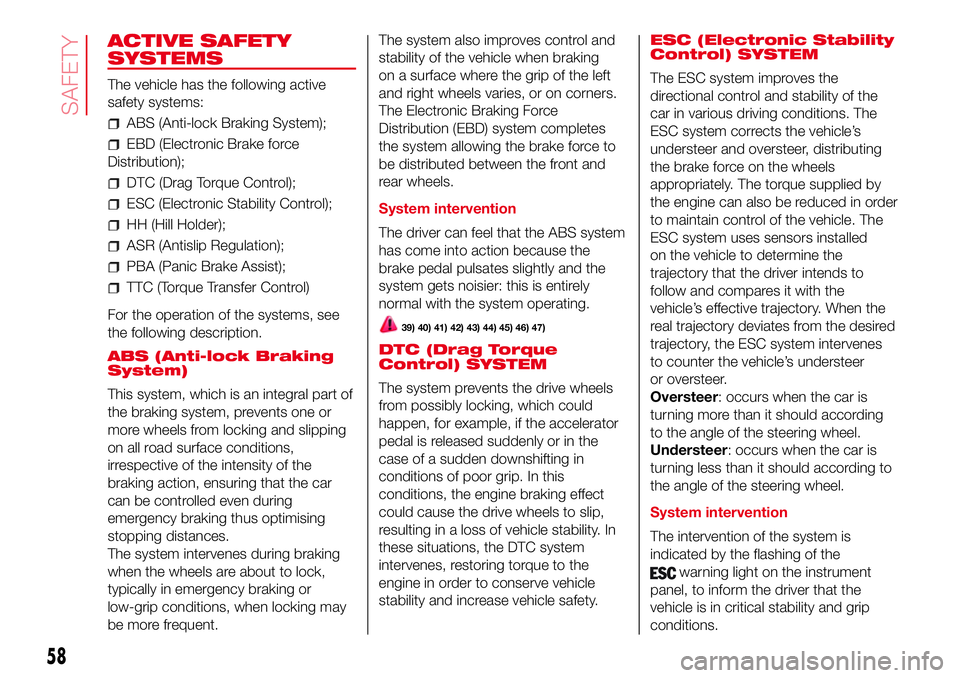
ACTIVE SAFETY
SYSTEMS
The vehicle has the following active
safety systems:
ABS (Anti-lock Braking System);
EBD (Electronic Brake force
Distribution);
DTC (Drag Torque Control);
ESC (Electronic Stability Control);
HH (Hill Holder);
ASR (Antislip Regulation);
PBA (Panic Brake Assist);
TTC (Torque Transfer Control)
For the operation of the systems, see
the following description.
ABS (Anti-lock Braking
System)
This system, which is an integral part of
the braking system, prevents one or
more wheels from locking and slipping
on all road surface conditions,
irrespective of the intensity of the
braking action, ensuring that the car
can be controlled even during
emergency braking thus optimising
stopping distances.
The system intervenes during braking
when the wheels are about to lock,
typically in emergency braking or
low-grip conditions, when locking may
be more frequent.The system also improves control and
stability of the vehicle when braking
on a surface where the grip of the left
and right wheels varies, or on corners.
The Electronic Braking Force
Distribution (EBD) system completes
the system allowing the brake force to
be distributed between the front and
rear wheels.
System intervention
The driver can feel that the ABS system
has come into action because the
brake pedal pulsates slightly and the
system gets noisier: this is entirely
normal with the system operating.
39) 40) 41) 42) 43) 44) 45) 46) 47)
DTC (Drag Torque
Control) SYSTEM
The system prevents the drive wheels
from possibly locking, which could
happen, for example, if the accelerator
pedal is released suddenly or in the
case of a sudden downshifting in
conditions of poor grip. In this
conditions, the engine braking effect
could cause the drive wheels to slip,
resulting in a loss of vehicle stability. In
these situations, the DTC system
intervenes, restoring torque to the
engine in order to conserve vehicle
stability and increase vehicle safety.ESC (Electronic Stability
Control) SYSTEM
The ESC system improves the
directional control and stability of the
car in various driving conditions. The
ESC system corrects the vehicle’s
understeer and oversteer, distributing
the brake force on the wheels
appropriately. The torque supplied by
the engine can also be reduced in order
to maintain control of the vehicle. The
ESC system uses sensors installed
on the vehicle to determine the
trajectory that the driver intends to
follow and compares it with the
vehicle’s effective trajectory. When the
real trajectory deviates from the desired
trajectory, the ESC system intervenes
to counter the vehicle’s understeer
or oversteer.
Oversteer: occurs when the car is
turning more than it should according
to the angle of the steering wheel.
Understeer: occurs when the car is
turning less than it should according to
the angle of the steering wheel.
System intervention
The intervention of the system is
indicated by the flashing of the
warning light on the instrument
panel, to inform the driver that the
vehicle is in critical stability and grip
conditions.
58
SAFETY